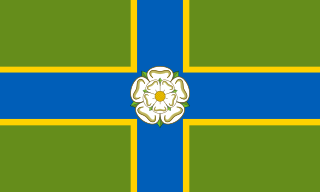Top Qs
Timeline
Chat
Perspective
Flags and symbols of Yorkshire
Flags and symbols of English county From Wikipedia, the free encyclopedia
Remove ads
The flags and symbols of Yorkshire are emblematic, representative, or otherwise characteristic of the Yorkshire and the Humber region of England, the historic county of Yorkshire, and their current and former subdivisions.

White rose
White rose
The white rose of York originated as the symbol of the House of York. It was later also used as a Jacobite symbol.
Yorkshire flag
Summarize
Perspective

The Yorkshire flag used to represent the historic county. It consists of a white rose of York on a blue field. How the colour blue came to be associated with the county is unclear, however it may have been influenced by the use of dark blue by the Queen's Own Yorkshire Dragoons and the Yorkshire County Cricket Club.[1]
The Flag Institute, a charity which promotes vexillology in the United Kingdom, claims the flag was designed in 1965 or earlier, and the Yorkshire Society claims that the Yorkshire Ridings Society adopted the flag in 1975.[2][3] It was registered with the Flag Institute on 29 July 2008 at the request of the Yorkshire Ridings Society.[4][5] Other designs proposed for the county flag included Saint George's Cross with a white rose-en-soleil (a rose superimposed on a sunburst) in the centre, and a red Nordic cross on a white field with a rose-en-soleil at the meeting point of the arms the cross.[1][6]
Use
The flag is flown within the historic boundaries of Yorkshire, including in areas of east Lancashire which were formerly within the county, and is flown around the county on Yorkshire Day on 1 August.[1][7][8] It was flown outside the Department for Communities and Local Government in London on Yorkshire Day in 2011 and 2013, and in Parliament Square on 23 July 2021 to mark Historic County Flag Day.[9][10][11]
The kit of the Yorkshire Vikings limited overs cricket team for the 2017 season featured a stylised version of the flag, and a large version of the flag was carried onto the pitch at a County Championship match between Yorkshire and Worcestershire in Scarborough in 2018.[12][13]
Remove ads
Riding flags
Summarize
Perspective
East Riding

The flag consists of a white rose of Yorkshire, which displayed in the East Riding style with one sepal at the top, on a green and blue bicolour. The blue is toward the hoist, representing the East Riding's connection to the rest of Yorkshire, and the green toward the fly to represent its position in the east of the historic county. The blue additionally represents the sea and the historic maritime activities of the East Riding, and the green symbolises the riding's agricultural land.[14]
The flag was chosen in 2013 following a competition and public vote on six shortlisted finalists.[14] The winning design was then unveiled at Beverley Minster.[15] The flag has been flown around the East Riding.[16] It was also flown from the building of the Department for Communities and Local Government in London in 2014.[17]
The flag was registered by the Flag Institute, a charity which promotes vexillology in the United Kingdom, on 18 April 2013.[14]
North Riding

The yellow edged blue cross recalls the colours (yellow stars on a blue background) of the arms attributed to the local saint, Wilfrid a major figure in the early history of the region. Set against a green field, the three colours in combination allude to the North Riding's natural features; the green representing the large tracts of the famed North York Moors National Park, while the blue and yellow reflect the North Sea coastline (with its sandy beaches at Saltburn, Runswick Bay and Redcar Beach for example) and such rivers as the Swale, Tees and Esk.[18]
The flag was registered by the Flag Institute, a charity which promotes vexillology in the United Kingdom, on 4 May 2013.[19]
West Riding

The flag features a "rose-en-soleil" device first used by Edward IV upon his accession to the throne, combining the White Rose of the House of York with the Sun emblem used by his royal predecessor, Richard II. In essence the rose-en-soleil is a more elaborate version of the white rose emblem associated with the county and had been used by the former West Riding council in its coat of arms. The rose emblem is placed against an offset red cross in Scandinavian style, reflecting the Anglo-Scandinavian history of the region during the era when the Ridings were first established. The cross may be seen therefore as a Nordic cross in English colours, a graphic encapsulation of local heritage and history.[20]
The flag was registered with the Flag Institute, a charity which promotes vexillology in the United Kingdom, on 23 May 2013.[21]
Riding flag competition finalists
The finalists of the competitions to decide the flags for the ridings were:
Remove ads
Council armorial
Summarize
Perspective
Current
Former
Administrative county councils
Between 1889 and 1974 the three ridings were administrative counties. Each council was eventually granted arms by the officers at the College of Arms, which were used until their abolition.
Metropolitan and non-metropolitan county councils
The Local Government Act 1972 replaced the three administrative counties with the metropolitan counties of South Yorkshire and West Yorkshire and the non-metropolitan counties of Cleveland, Humberside, and North Yorkshire. They came into being on 1 April 1974, and all five were granted arms in the next four years.
On 1 April 1986 the two metropolitan county councils were abolished under the Local Government Act 1985 and their functions transferred primarily to the metropolitan districts of each county. On 1 April 1996 the non-metropolitan counties of Cleveland and Humberside and their county councils were abolished.
Remove ads
British Army
Maritime flags
Yacht and sailing clubs
Shipping companies
Remove ads
See also
- Flying Colours Flagmakers company based in North Yorkshire
References
Wikiwand - on
Seamless Wikipedia browsing. On steroids.
Remove ads














































